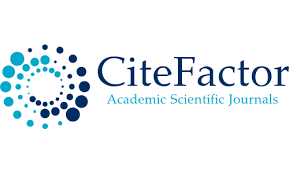Polymer-Polymer Complexes for the Protection of the Aquatic Environment
Keywords:
Polymer-polymer complex, carboxymethylcellulose, urea-formaldehyde resin, kilnAbstract
The aim of the given work is prevention on wind and water erosion and an improvement of quality of ground, as well as increasing the efficiency of pouring water by using demoralized ecological harmless and economic available polymer-polymer complexes (PPC). In last cheats significant successes in making a new class of modified polymeric material, which has allowed to mark new directions in the field of the physicist-chemistries of polymers. PPC are new broad class of polymeric combinations that find a practical application as desperation membranes, coverings, efficient, materials for medical purpose, medicine facilities, in the process of division of albumen and others. Known in the literature PPC on the base of synthetics corboconnection polymers an complementary stature have low level for using them in the agriculture, in consequence of their low biodistruetion and high cost. The rich possibilities presented PPC, can be marked in bid degrees in the process of high tonnage polymers, such as carboxymetilcellulose (CMC), of from the polymer of natural origin and that can come interaction urineformaldehyde resins (UFR). The main values of these products is connected with their low prices and accessibility and possibility of regulation a physicist chemical getting product characteristics. Obvious advantages of large sealed using specified PPC in the agriculture, for instance, for preventing a windy and water erosion of ground, as well as perfecting of its agrophysical characteristics. In the work develop fundamental approaches to making an efficient technology of getting and using the polymer-polymer complex.
References
Mukhamedov G.I., Khafizov M.M., Khasanhanova M.M., Iskandarov S.I., Zezin A.B.//Reports of the Academy of Science of th e USSR, 1989. vol. 306. No.2, p. 386.
Lapshin I. Z., Turgumbaeva H. H., Beisekova T. I. Physico-chemical properties of phosphogypsum placed on the blade of Zhambyl plant of mineral fertilizers. // Industry Of Kazakhstan, No. 5. – 2012. – P. 56-58.
Vyshpolsky F. F., Mukhamedzhanov, H. V., Kydyr M., Karimov A. Application of phosphogypsum for the amelioration of the fused soil (alkaline, magnesium osolontsevanie) in southern Kazakhstan. //Herald of agricultural science of Kazakhstan, №4. – 2006. – P. 37-40.
Kamilov K. U. Nestekhiometriya interpolymer complexes based on urea formaldehyde resin and particulate fillers Diss. kand. tech. Sciences. – Tashkent: 2005
Recommendations for reclamation of sodic lands. - M.: Kolos,2003.- 46 p.
Ivanitsky V. V., Klassen P. V., Novikov A. A. Phosphogypsum and its use. – M.: Chemistry, 2000. - 224 p.
Chikov V. I., Bun M. E., Antonov V. G. Influence of fruit removal on photosynthetic metabolism in leaves of cotton, 1985, Institution of Russian Academy of Sciences, Kazan Institute of biochemistry and Biophysics.
Ahmadjonov D. G. Irrigation regime cotton irrigation water-saving techniques // Journal of Аgroilm. –Tashkent, 2010. — № 3(15). — S. 13-14.
Mukhamedov, I. Z. Karimov, Ahmadjonov D. G., M. M. Hafiz, G. A. Akhmedzhanov recommendations on the use of PKI and the creation of impervious screen to save irrigation water. — Tashkent, 2008, p. 17.
Komilov K.U., Kurbanova A. Dj., Muhamedov G.I. New Technology of Cotton Sowing. An Interdisciplinary Journal Psychology and education. 2021 58(2), 296-303.
Комилов К.У., Курбанова А.Дж., Ахмедов А.М. Полученые композиционных материалов на основе полимер-полимерных комплексов// Вестник НамГУ. 2019, № 3 (3), С.- 36-41.
Комилов К.У., Ходжибеков С.Н. Экономическая целесообразность использования фосфогипса в сельском хозяйстве// АГРО ИЛМ. 2019, №1, С.-66-68.
Комилов К.У., Ходжибеков С.Н. Режим полива при использовании нестихиометричных интерполимерных комплексов// АГРО ИЛМ. 2019, №2, С.- 70-72.
Комилов К.У. Носирова С.Ш. Гидроэкологик муаммолар ва уларни бартараф этишда полимер комплекслардан фойдаланиш// Экология хабарномаси. 2019, №1 (1), 23-26 бетлар.
Инхонова А., Курбанова А. Dj., Комилов Q. O'. Полимер-полимер комплекслар асосида модификацияланган интерполимер материаллар//Academic research in educational sciences, 2020, №2, padge 44-49.
Комилов К.У., Курбанова А.Дж., Ниёзов Х.А., Мухамедов Г.И. Использование фосфогипса для улучшения мелиоративных свойств почвы// Academic Research in Educational Sciences. 2020, № 1, C.- 97-101.
Yigitaliyiva R., Komilov Q.O‘., Kurbanova A.Dj. GIS application when using phosphogyptic compositions to improve meliorative soil properties// International Engineering Journal For Research & Development.2020, Vol.5 Issue 8. Pade.1-6. https://doi.org/10.17605/OSF.IO/7P42N
Mukhamedov G.I., KomilovQ.O‘, Kurbanova A.Dj., Niyozov Kh. A. Interpolymeric complex for protection of the biosphere and spare water resources// Journal of Critical Reviews. 2020, №2, Pade. 230-233.
Комилов К.У., Курбанова А.Дж., Ниёзов Х.А., Мухамедов Г.И. Экономическая целесообразность использования фосфогипса в сельском хозяйстве/ Материалы Национальной научной конференции г.Волгаград, 29-30 октября 2020 г . 1 том, №1. С.-261-264.
Комилов К.У., Курбанова А.Дж., Носирова С.Ш., Каримбаева С. Получение внутрипочвенного экрана из полимер-полимерных комплексов/Материалы конференции Monografia, Pokonferencyjna science, Research. Польша, №2, том 26, С.-102-104.
Downloads
Published
Issue
Section
License

This work is licensed under a Creative Commons Attribution-NonCommercial 4.0 International License.
User Rights
Under the Creative Commons Attribution-NonCommercial 4.0 International (CC-BY-NC), the author (s) and users are free to share (copy, distribute and transmit the contribution).
Rights of Authors
Authors retain the following rights:
1. Copyright and other proprietary rights relating to the article, such as patent rights,
2. the right to use the substance of the article in future works, including lectures and books,
3. the right to reproduce the article for own purposes, provided the copies are not offered for sale,
4. the right to self-archive the article.












